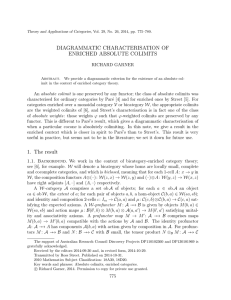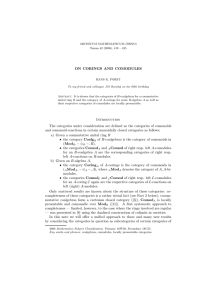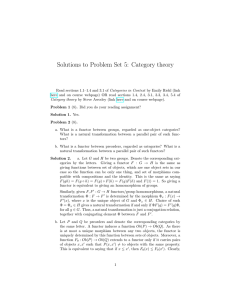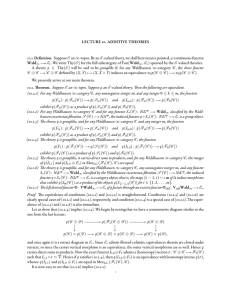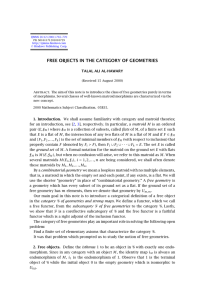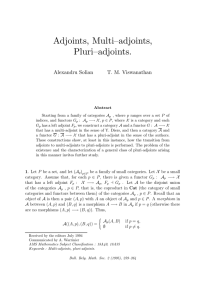GENERALIZED BROWN REPRESENTABILITY IN HOMOTOPY CATEGORIES: ERRATUM JI ˇ R´I ROSICK ´
advertisement
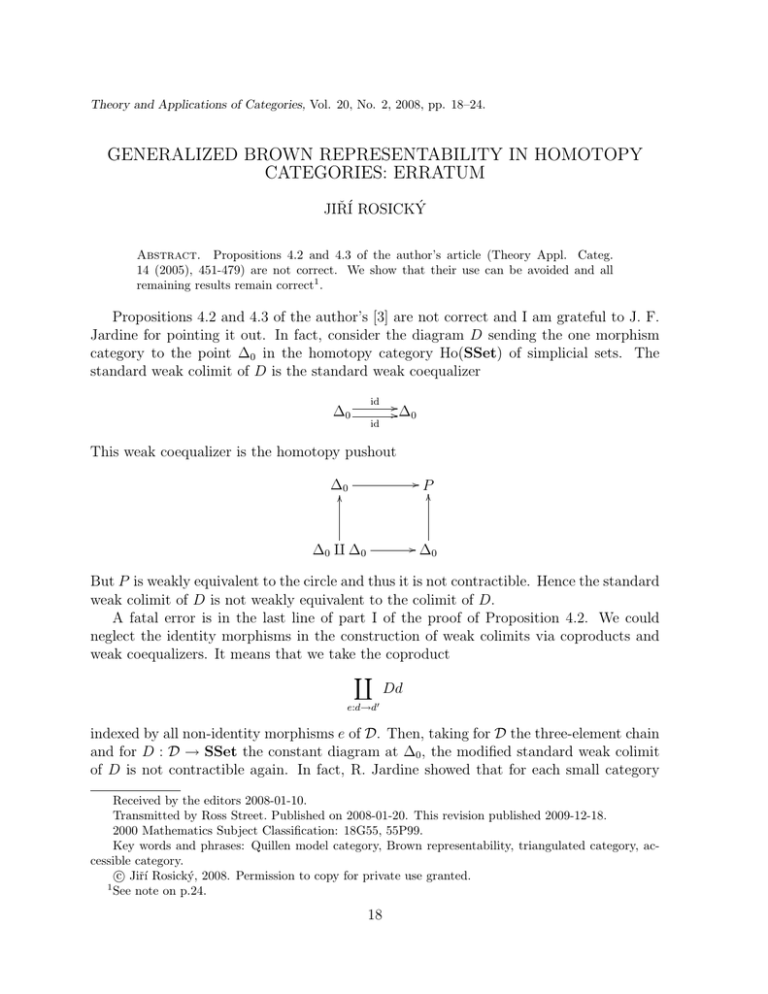
Theory and Applications of Categories, Vol. 20, No. 2, 2008, pp. 18–24.
GENERALIZED BROWN REPRESENTABILITY IN HOMOTOPY
CATEGORIES: ERRATUM
JIŘÍ ROSICKÝ
Abstract. Propositions 4.2 and 4.3 of the author’s article (Theory Appl. Categ.
14 (2005), 451-479) are not correct. We show that their use can be avoided and all
remaining results remain correct1 .
Propositions 4.2 and 4.3 of the author’s [3] are not correct and I am grateful to J. F.
Jardine for pointing it out. In fact, consider the diagram D sending the one morphism
category to the point ∆0 in the homotopy category Ho(SSet) of simplicial sets. The
standard weak colimit of D is the standard weak coequalizer
∆0
id
id
/
/ ∆0
This weak coequalizer is the homotopy pushout
/
∆O 0
/
∆0 q ∆0
PO
∆0
But P is weakly equivalent to the circle and thus it is not contractible. Hence the standard
weak colimit of D is not weakly equivalent to the colimit of D.
A fatal error is in the last line of part I of the proof of Proposition 4.2. We could
neglect the identity morphisms in the construction of weak colimits via coproducts and
weak coequalizers. It means that we take the coproduct
a
Dd
e:d→d0
indexed by all non-identity morphisms e of D. Then, taking for D the three-element chain
and for D : D → SSet the constant diagram at ∆0 , the modified standard weak colimit
of D is not contractible again. In fact, R. Jardine showed that for each small category
Received by the editors 2008-01-10.
Transmitted by Ross Street. Published on 2008-01-20. This revision published 2009-12-18.
2000 Mathematics Subject Classification: 18G55, 55P99.
Key words and phrases: Quillen model category, Brown representability, triangulated category, accessible category.
c Jiřı́ Rosický, 2008. Permission to copy for private use granted.
1
See note on p.24.
18
GENERALIZED BROWN REPRESENTABILITY: ERRATUM
19
D and each diagram D : D → SSet constant at ∆0 , the weak standard colimit of D is
weakly equivalent to the graph of D. The graph of the three-element chain 0 < 1 < 2
contains the boundary of the simplex ∆1 but not ∆1 itself. It does not seem possible to
find a modification of standard weak colimits satisfying Proposition 4.2.
These incorrect results were used only for proving Theorems 5.4 and 5.7 (numbered
references here and below are for results in [3]). Fortunately, we can avoid their use.
Theorem 5.4 says that the functor
Eλ : Ho(K) → Indλ (Ho(Kλ ))
is essentially surjective on objects, i.e., that for each X in Indλ (Ho(Kλ )) there is K in
Ho(K) with Eλ K ∼
= X. Theorem 5.7 then adds that Eλ is full. This formulation is
not correct and one has to replace it by Eλ being essentially surjective in the sense that
every morphism f : X → Y in Indλ (Ho(Kλ )) is isomorphic to Eλ (g) in the category of
morphisms of Indλ (Ho(Kλ )) for some g : K → L. The latter means the commutativity of
a square
EλO K
Eλ (g)
/
EλO L
∼
=
X
∼
=
f
/
Y
An essentially surjective functor is essentially surjective on objects (by using f = idX ).
Thus the correct formulation of Theorems 5.4 and 5.7 is the following statement.
1.1. Theorem. Let K be a locally λ-presentable model category satisfying the conditions
(G1λ ) and (G2λ ). Then the functor
Eλ : Ho(K) → Indλ (Ho(Kλ ))
is essentially surjective.
Proof. Since (G1λ ) implies (G4λ ) (by Remark 3.4), it follows from Corollary 5.2 that
it suffices to prove that Indλ Pλ is essentially surjective. At first, we prove that it is
essentially surjective on objects. We start in the same way as in the proof of Theorem
5.4. We consider an object X in Indλ (Ho(Kλ )) and express it as a λ-filtered colimit
(δd : Dd → X) of the canonical diagram D : D → Ho(Kλ ). Without any loss of generality,
we can assume that Dd belong to Kcf for all d in D. Then we take a standard weak colimit
(δ d : Dd → K) of the lifting D of D along Eλ . Standard weak colimits are given by a
construction in K and let K be the resulting object. Thus K = P K and we can assume
that K is in Kcf . In K, λ-filtered colimits commute both with coproducts and with
homotopy pushouts. The second claim follows from the fact that homotopy pushouts are
constructed via pushouts and (cofibration, trivial fibration) factorizations and the latter
preserve λ-filtered colimits (by (G1λ )). Consequently, λ-filtered colimits commute in K with
the construction of standard weak colimits and thus K is a λ-filtered colimit αE : K E → K
20
JIŘÍ ROSICKÝ
of objects K E giving standard weak colimits of λ-small subdiagrams DE : E → Ho(Kλ )
of D. All objects K E belong to Kλ . We can even assume that each E has a terminal
object dE . Let uE : DdE → Pλ K E be the corresponding component of a standard weak
colimit cocone. Clearly, these morphisms form a natural transformation from D to the
the diagram consisting of Pλ K E . Since dE is a terminal object of E, there is a morphism
sE : Pλ K E → DdE with sE uE = idDdE . Thus each morphism uE is a split monomorphism.
Thus the colimit
u : X → Eλ K = (Indλ Pλ )K
of Eλ (uE ) is a λ-pure monomorphism (see [1]). This argument is a correct part of the
proof of Proposition 4.3.
Now, consider a pullback
KO λ
Pλ
/
Ho(Kλ )
O
D
D
D
/
P
D
We will show that the functor P : D → D is final. Observe that, for each object d in D,
we have P (d) = QRd and the same for morphisms. For each object d in D, there is d
in D with d = P (d). Consider two morphisms f1 : d → P (d1 ) and g1 : d → P (d2 ) in D.
Since D is λ-filtered, there is a commutative square (where we replace P by QR)
QRd
O 1
h2
/e
O
f1
h1
d
/
g1
QRd2
in D. Let α : Id K → Rf and β : Rc → Id K be natural transformation given by fibrant
and cofibrant replacements. Since α is a pointwise trivial cofibration and β is a pointwise
trivial fibration, both QRα and QRβ are natural isomorphisms. Thus we get the following
zig-zags in the comma category d ↓ P
f1 o
QRβd¯
g1 o
QRβd¯
1
f2
QRαRc d¯
/ f3
QRh2
/ f4
QRαRc d¯
/ g3
QRh1
/ g4
1
and
2
g2
2
Here, f2 = QR(βd1 )−1 · f1 and f3 , f4 are the corresponding compositions; analogously for
g1 . Since f4 = g4 , f1 and g1 are connected by a zig-zag in the category d ↓ P . Thus the
functor P is final. Consequently,
X∼
= colim(P · D).
= colim D ∼
GENERALIZED BROWN REPRESENTABILITY: ERRATUM
21
The latter object is isomorphic to
(Indλ Pλ ) colim D
provided that the diagram D is λ-filtered. Evidently2 , this diagram is λ-filtered when
X∼
= (Indλ Pλ )L for some L in K. Thus X belongs to the essential image of Indλ Pλ if and
only if the corresponding diagram DX is λ-filtered (the index X denotes that D belongs
to X).
Consider X and a λ-small subcategory A of DX . Since the functor Pλ preserves λ-small
coproducts, we can assume that A consists of morphisms
hi : DX d1 → DX d2 ,
i ∈ I where card I < λ. Then hi , i ∈ I are morphisms uδd1 → uδd2 in the diagram DY
for Y = (Indλ Pλ )K. Since the latter diagram is λ-filtered, there are f : Pλ A → Y and
h : DX d2 → A such that h coequalizes all hi , i ∈ I and f Pλ (h) = uδd2 . Since u is λ-pure,
there is g : Pλ A → X such that gPλ (h) = δd2 . Thus h : δd2 → g coequalizes hi , i ∈ I in
DX . We have proved that DX is λ-filtered and thus
X∼
= (Indλ Pλ ) colim DX .
We have thus proved that Indλ Pλ is essentially surjective on objects.
Now, consider a morphism h : X → Y in Indλ (Ho(Kλ )) and express X and Y as
canonical λ-filtered colimits (δXd : DX d → X) and (δY d : DY d → Y ) of objects from
Ho(Kλ ). Let DX : DX → Kλ and DY : DY → Kλ be the diagrams constructed above.
The prescription Hf = hf yields a functor
H : DX → DY
such that DY H = DX . Since the diagrams DX and DY are given by pullbacks, there is
a functor
H : DX → DY
such that DY H = DX . This gives a morphism
h : colim DX → colim DY
such that (Indλ Pλ )h ∼
= h. Thus the functor Indλ Pλ is essentially surjective.
2
This is in error, see note on p. 24.
22
JIŘÍ ROSICKÝ
We say that a locally λ-presentable model category K is essentially λ-Brown provided
that the functor Eλ is essentially surjective. Thus the correct formulation of Corollary
5.8 is as follows.
1.2. Corollary. Let K be a locally λ-presentable model category satisfying the conditions (G1λ ) and (G2λ ). Then K is essentially λ-Brown.
Thus, for a combinatorial model category K, there are arbitrarily large regular cardinals λ such that K is essentially λ-Brown. Recall that K is λ-Brown if Eλ is essentially
surjective on objects and full. The original formulation of Corollary 5.9 remains true for
stable model categories.
1.3. Proposition. Let K be a locally λ-presentable model category satisfying the conditions (G1λ ), (G2λ ) and such that Eλ reflects isomorphisms. Then K is λ-Brown.
Proof. Consider a morphism h : Eλ P K1 → Eλ P K2 . In the proof of the Theorem above,
we have found a morphism h : L1 → L2 such that Eλ P h ∼
= h. Following the construction
of objects L1 and L2 , there are morphisms ti : Ki → Li , i = 1, 2, such that
(Eλ P (t1 ), Eλ P (t2 )) : h → Eλ P h
is an isomorphism. The reason is that the canonical diagram of Ki with respect to Kλ is a
subdiagram of the diagram Di constructed in the proof above and Li = colim Di , i = 1, 2.
Since Eλ reflects isomorphisms, P (t1 ) and P (t2 ) are isomorphisms. We get the morphism
h0 = P (t2 )−1 P (ht1 ) : P K1 → P K2
with Eλ (h0 ) = h. Thus Eλ is full.
1.4. Corollary. Let K be a combinatorial stable model category. Then there are arbitrarily large regular cardinals λ such that K is λ-Brown.
Proof. It follows from Proposition 6.1, the proof of Proposition 6.4 and the Proposition
above.
1.5. Remark. 5.11 (3) implies a correct substitute of Proposition 4.3 saying that, for
a stable locally λ-presentable model category K satisfying the conditions (G1λ ) and (G2λ ),
the functor P : K → Ho(K) sends λ-filtered colimits of λ-presentable objects to minimal
weak λ-filtered colimits.
The distinction between being Brown and essentially Brown is important, which is
manifested by the following strengthening of Proposition 6.11.
1.6. Proposition. Let K be a model category which is λ-Brown for arbitrarily large
regular cardinals λ. Then idempotents split in Ho(K).
23
GENERALIZED BROWN REPRESENTABILITY: ERRATUM
Proof. Let f : P K → P K be an idempotent in Ho(K). There is a regular cardinal λ such
that K is λ-Brown and K is λ-presentable in K. Since idempotents split in Indλ (Ho(Kλ )),
there are morphisms p : Eλ K → Eλ L and u : Eλ L → Eλ K such that pu = idEλ and
Eλ f = up. Since Eλ is full, there are morphisms p : K → L and u : L → K with Eλ p = p
and Eλ u = u. Since Eλ is faithful on Ho(Kλ ), we have pu = idK and f = up. Hence
idempotents split in Ho(K).
Now, Remark 6.12 implies that SSet cannot be λ-Brown for arbitrarily large regular
cardinals λ.
The proof of Proposition 6.10 is lacking a verification that each object A from Ho(Kµ )
is µ-small. Also, the proof that Ho(Kµ ) is µ-perfect has to be corrected because the coproduct of fibrant objects does not need to be fibrant and its fibrant replacement destroys
the coproduct structure in K. I am grateful to B. Chorny for bringing these gaps to my
attention. In what follows, a corrected proof of Proposition 6.12 is presented. Its first
two paragraphs and the last one remain unchanged. This means that we are replacing
the third paragraph of the proof.
We will show that each object A from Ho(Kµ ) is µ-small. Recall that, following Remark
2.4 (2), K satisfies the conditions (Giµ ) for i = 1, 2, as well, and thus it is µ-Brown (see
the Corollary above). Consider a morphism
a
Ki
f :A→
i∈I
in Ho(K). We have
a
Ki ∼
= colim
i∈I
a
Kj
j∈J
where the colimit is taken over all subsets J ⊆ I having cardinality smaller than µ. Since
a
a
Kj
Eµ colim
Kj ∼
= colim Eµ
j∈J
j∈J
`
Kj . Thus f factorizes through some
Kj .
j∈J
j∈J
`
It remains to show that Ho(Kµ ) is µ-perfect. Consider a morphism f : A →
Ki in
(see 6.5), Eµ f factorizes through some Eµ
`
i∈I
Ho(K) where card I < µ. Each Ki , i ∈ I, is a minimal µ-filtered colimit
(kji : Aij → Ki )j∈Ji
of objects Aij ∈ Ho(Kµ ). Hence all subcoproducts X =
`
Aiji belong to Ho(Kµ ). Let
i∈I
Z be their minimal
` weak µ-filtered colimit. Since minimal weak colimits commute with
∼
coproducts, Z =
Ki .
i∈I
Thus Eµ f factorizes through some Eµ X of some subcoproduct X and therefore f
factorizes through X, which yields [2], 3.3.1.2 in the definition of perfectness.
24
JIŘÍ ROSICKÝ
References
[1] J. Adámek and J. Rosický, Locally Presentable and Accessible Categories, Cambridge
University Press 1994.
[2] A. Neeman, Triangulated Categories, Princeton Univ. Press 2001.
[3] J. Rosický, Generalized Brown representability in homotopy categories, Theory and
Applications of Categories 14(2005), 451–479.
This erratum contains a mistake. It is not true that the diagram DX is λ-filtered provided
that the object X belongs to the essential image of Indλ Pλ (see page 21, lines 4 and 5).
Thus the claims of Theorems 5.4, 5.7 and their Corollaries 5.8, 5.9 and 5.10 remain open.
I am grateful to F. Muro for pointing it out. Proposition 6.12 does not depend on these
results because it follows from Proposition 5.1 only. Hence the original article proves that
the homotopy category of a combinatorial stable model category is well generated.
Department of Mathematics
Masaryk University
602 00 Brno, Czech Republic
Email: rosicky@math.muni.cz
This article may be accessed at http://www.tac.mta.ca/tac/ or by anonymous ftp at
ftp://ftp.tac.mta.ca/pub/tac/html/volumes/20/2/20-02.{dvi,ps,pdf}
THEORY AND APPLICATIONS OF CATEGORIES (ISSN 1201-561X) will disseminate articles that
significantly advance the study of categorical algebra or methods, or that make significant new contributions to mathematical science using categorical methods. The scope of the journal includes: all areas of
pure category theory, including higher dimensional categories; applications of category theory to algebra,
geometry and topology and other areas of mathematics; applications of category theory to computer
science, physics and other mathematical sciences; contributions to scientific knowledge that make use of
categorical methods.
Articles appearing in the journal have been carefully and critically refereed under the responsibility of
members of the Editorial Board. Only papers judged to be both significant and excellent are accepted
for publication.
Full text of the journal is freely available in .dvi, Postscript and PDF from the journal’s server at
http://www.tac.mta.ca/tac/ and by ftp. It is archived electronically and in printed paper format.
Subscription information. Individual subscribers receive abstracts of articles by e-mail as they
are published. To subscribe, send e-mail to tac@mta.ca including a full name and postal address. For institutional subscription, send enquiries to the Managing Editor, Robert Rosebrugh, rrosebrugh@mta.ca.
Information for authors.
The typesetting language of the journal is TEX, and LATEX2e
strongly encouraged. Articles should be submitted by e-mail directly to a Transmitting Editor. Please
obtain detailed information on submission format and style files at http://www.tac.mta.ca/tac/.
Managing editor. Robert Rosebrugh, Mount Allison University: rrosebrugh@mta.ca
TEXnical editor. Michael Barr, McGill University: barr@math.mcgill.ca
Assistant TEX editor. Gavin Seal, McGill University: gavin seal@fastmail.fm
Transmitting editors.
Clemens Berger, Université de Nice-Sophia Antipolis, cberger@math.unice.fr
Richard Blute, Université d’ Ottawa: rblute@uottawa.ca
Lawrence Breen, Université de Paris 13: breen@math.univ-paris13.fr
Ronald Brown, University of North Wales: ronnie.profbrown (at) btinternet.com
Aurelio Carboni, Università dell Insubria: aurelio.carboni@uninsubria.it
Valeria de Paiva, Cuill Inc.: valeria@cuill.com
Ezra Getzler, Northwestern University: getzler(at)northwestern(dot)edu
Martin Hyland, University of Cambridge: M.Hyland@dpmms.cam.ac.uk
P. T. Johnstone, University of Cambridge: ptj@dpmms.cam.ac.uk
Anders Kock, University of Aarhus: kock@imf.au.dk
Stephen Lack, University of Western Sydney: s.lack@uws.edu.au
F. William Lawvere, State University of New York at Buffalo: wlawvere@acsu.buffalo.edu
Tom Leinster, University of Glasgow, T.Leinster@maths.gla.ac.uk
Jean-Louis Loday, Université de Strasbourg: loday@math.u-strasbg.fr
Ieke Moerdijk, University of Utrecht: moerdijk@math.uu.nl
Susan Niefield, Union College: niefiels@union.edu
Robert Paré, Dalhousie University: pare@mathstat.dal.ca
Jiri Rosicky, Masaryk University: rosicky@math.muni.cz
Brooke Shipley, University of Illinois at Chicago: bshipley@math.uic.edu
James Stasheff, University of North Carolina: jds@math.unc.edu
Ross Street, Macquarie University: street@math.mq.edu.au
Walter Tholen, York University: tholen@mathstat.yorku.ca
Myles Tierney, Rutgers University: tierney@math.rutgers.edu
Robert F. C. Walters, University of Insubria: robert.walters@uninsubria.it
R. J. Wood, Dalhousie University: rjwood@mathstat.dal.ca

